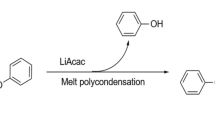Abstract
In this study, the effects of bisphenol A (BPA) and diphenyl carbonate (DPC) molar ratio, on the properties of melt-polymerized polycarbonate (PC) were investigated. The molecular size distribution theory proposed by Flory was applied, to melt polymerization of PC to predict physical properties, affected by the molar ratio of BPA and DPC. A terminal OH group affected the viscosity of PC at high temperatures, leading to instability during processing. With increase in the DPC/BPA molar ratio, terminal OH content decreased, albeit different from the theoretical predicted value, because of the volatilization of DPC. Additionally, BPA residual amount was affected by BPA and DPC molar ratio. BPA is regulated in countries because of its similarity to estrogen, and BPA residues can be predicted and managed by using the Flory equation.

Similar content being viewed by others
References
J. A. King, Jr., D. G. LeGrand, and J. T. Bendler, Handbook of Polycarbonate Science and Technology, Marcel Dekker, New York, 2000, Chap. 2.
H. Schnell, Chemistry and Physics of Polycarbonates, Wiley, New York, 1964, Chap. 3.
H. Schnell, L. Bottenbruch, and H. Krimm, US Patent 3028365 (1962).
D. W. Fox, General Electric Company, US Patent 3153008 (1964).
D. W. Fox, General Electric Company, US Patent 3148172 (1964).
D. W. Fox, Polycarbonates, in Kirk-Othmer Encyclopedia of Chemical Technology, 3rd ed., John Wiley and Sons, New York, 1982, Vol. 18, p 479.
T. Sakashita and T. Shimoda, GE Plastics Japan, European Patent A3511168 (1988).
S. Fukuoka, I. Fukawa, and M. Tojo, Green Chemistry, 5, 497 (2003).
A. V. Krishnan, P. Stathis, S. F. Permuth, L. Tokes, and D. Feldman, Endocrinology, 132, 2279 (1993).
L. A. Vrooman, J. M. Oatley, J. E. Griswold, T. J. Hassold, and P. A. Hunt, PLOS Genetics, 11, 1 (2015).
C. Han and Y. C. Hong, Curr. Hypertens. Rep., 18, 11 (2016).
https://doi.org/www.fda.gov/food/food-additives-petitions/bisphenol-bpa-use-food-contact-application.
Danish Ministry of Environment, Migration of Bisphenol A from Polycarbonate Plastic of Different Qualities, Environmental Project No. 1710 (2015).
D. Lemus, The Regulation of Bisphenol A in Denmark and Norway: How the Problem of Chemical Safety is Framed and Addressed Amidst Scientific Uncertainty, Norwegian Univ. of Life Science, Master Thesis (2015).
K. Inoue, General Electric Company, US Patent 6022943A (1999).
P. J. Flory, J. Am. Chem. Soc, 58, 1877 (1936).
P. J. Flory, J. Am. Chem. Soc, 64, 2205 (1942).
J. R. Shaefgen and P. J. Flory, J. Am. Chem. Soc., 70, 2709 (1948).
P. J. Flory, Principles of Polymer Chemistry, Cornell Univ. Press, Ithaca, New York, 1953, Chap 8.
J. Kim, H. S. Gracz, G. W. Roberts, and D. J. Kiserow, Polymer, 49, 394 (2008).
S. N. Hersh and K. Y. Choi, J. Appl. Polym. Sci., 41, 1033 (1990).
Y. Kim and K. Y. Choi, J. Appl. Polym. Sci., 49, 747 (1993).
Author information
Authors and Affiliations
Corresponding author
Additional information
Publisher’s Note Springer Nature remains neutral with regard to jurisdictional claims in published maps and institutional affiliations.
Acknowledgment: This work was supported by the Research Fund (PNK6080) of Korea Institute of Materials Science (KIMS).
Rights and permissions
About this article
Cite this article
Lim, B.H., Yi, J.W. & Park, O.O. Effect of the Monomer Ratio on the Properties of Melt-Polymerized Polycarbonate. Macromol. Res. 27, 1221–1228 (2019). https://doi.org/10.1007/s13233-019-7169-2
Received:
Revised:
Accepted:
Published:
Issue Date:
DOI: https://doi.org/10.1007/s13233-019-7169-2




